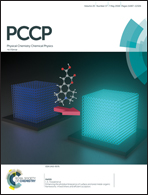Electron paramagnetic resonance of a copper doped [(CH3)2NH2][Zn(HCOO)3] hybrid perovskite framework†
Abstract
We report a continuous-wave (CW) and pulse electron paramagnetic resonance (EPR) as well as pulse electron nuclear double resonance (ENDOR) study of Cu2+ doped [(CH3)2NH2][Zn(HCOO)3] hybrid perovskite which exhibits a structural phase transition. The multifrequency (X, Q and W-band) CW EPR measurements allow the temperature evolution of the Cu2+ ion local environment to be studied. The spectrum of the ordered (low-temperature) phase reveals an axially distorted octahedral Cu2+ site confirming the successful replacement of the Zn2+ ions and formation of the CuO6 octahedra. The CW EPR spectrum of the disordered (high-temperature) phase shows an additional broad line which gradually diminishes on cooling. The EPR linewidth of the axially symmetric Cu2+ ion site exhibits an anomaly at the phase transition point and Arrhenius-type behavior in the disordered phase. The temperature dependent Cu2+ spin Hamiltonian parameters change abruptly at the phase transition point indicating a strong first-order character of the transition. The X-band pulse ENDOR spectrum of the ordered phase reveals several protons in the vicinity of the Cu2+ center.
![Graphical abstract: Electron paramagnetic resonance of a copper doped [(CH3)2NH2][Zn(HCOO)3] hybrid perovskite framework](/en/Image/Get?imageInfo.ImageType=GA&imageInfo.ImageIdentifier.ManuscriptID=C8CP01426D&imageInfo.ImageIdentifier.Year=2018)


 Please wait while we load your content...
Please wait while we load your content...